Optimal Temperatures for Commercial Freezers
Posted by MARIA KATO

Maintaining the correct temperature in a commercial freezer goes beyond simply keeping food cold; it’s essential for food safety and quality control. Whether you operate a restaurant, grocery store, or other food-related business, knowing and managing the ideal freezer temperature can safeguard your inventory, ensure compliance with health regulations, and help you save money.
This article covers the importance of setting your commercial freezer to the proper temperature, the factors that affect those temperatures, and how to maintain consistency for peak performance.
Standard Temperature Range for Commercial Freezers
Most commercial freezers are designed to operate within a temperature range of -18°C to -22°C (0°F to -7.6°F). This range is essential for preserving food quality and preventing bacteria growth. Freezing food at -18°C or lower ensures it remains solidly frozen, stopping the spread of harmful pathogens that can cause foodborne illnesses.
At these temperatures, microbial activity is halted, slowing down spoilage and extending the shelf life of items like meats, seafood, and prepared foods. If temperatures rise above this range, even slightly, food may start to thaw, promoting bacteria growth and reducing quality.
Following this standard temperature range is crucial for food safety and helps maintain the flavor, texture, and nutritional value of frozen goods.
The Impact of Temperature on Food Quality and Safety
Maintaining the correct freezer temperature is essential for ensuring both food safety and quality. At -18°C or lower, food becomes dormant, preventing bacterial growth. However, if the temperature rises or fluctuates, even briefly, bacteria can start to multiply, potentially leading to foodborne illnesses.
Consistent temperature control also plays a significant role in preserving food quality. When temperatures are too warm, the texture of food can degrade. For example, ice crystals may form within food items such as vegetables, causing freezer burn. This condition leads to moisture loss and changes in texture, taste, and appearance.
Freezer burn happens when air reaches the food's surface, drying it out and giving it a tough or chewy texture. Although freezer-burned food is safe to eat, its quality is noticeably reduced. Keeping the freezer at the correct temperature helps retain the food’s original texture and flavor—something especially important in commercial settings where customer experience matters.
Factors That Affect Freezer Temperatures
Many things can impact the temperature inside a commercial freezers, and businesses need to address them to keep food safe. For instance, opening the freezer door too often lets warm air inside, raising the temperature. Training staff to limit door openings can help maintain stable conditions.
Overcrowding the freezer is another issue. While trying to use as much space as possible is common, overloading blocks airflow. Proper circulation of cold air is necessary to keep temperatures consistent, and overcrowding can lead to uneven freezing.
Equipment problems, like faulty thermostats, damaged seals, or evaporator fan issues, also affect freezer temperatures. Regular maintenance and inspections are essential to prevent these problems from causing food spoilage or expensive repairs.
The Impact of Climate and Surrounding Temperature on Freezers
The surrounding environment plays a key role in how well a commercial freezer performs. Freezers located in hot areas, like busy kitchens or rooms with changing temperatures, often find it harder to keep internal temperatures stable. In hotter conditions, the freezer's compressor works harder, which can lead to wear and tear or even breakdowns.
Placing the freezer in a cooler, ventilated spot can help reduce stress on its components. Proper insulation is also important to block external heat from affecting the freezer's interior. For businesses in hot climates, choosing energy-efficient models or adding cooling features can ensure consistent performance all year round.
Ensuring Accurate Freezer Temperature Monitoring and Maintenance
Regularly monitoring freezer temperatures is crucial for maintaining the best conditions. While many modern commercial freezers come with digital thermostats, it’s still a good practice to manually check the temperature daily with a thermometer to ensure accuracy. Recording these temperature readings is essential to track any patterns of fluctuations, which could indicate an underlying issue.
Additionally, investing in freezers with built-in alarms that notify staff of temperature changes can help prevent spoilage by alerting them to problems early. If a temperature increase is detected, taking immediate corrective measures—such as adjusting the thermostat or servicing the unit—can save businesses thousands of dollars in potential inventory losses.
Signs of a Failing Commercial Freezer
Identifying early signs of a failing freezer can help you avoid bigger and more expensive problems. One obvious indicator is temperature inconsistency. If food is thawing and refreezing, the freezer isn’t maintaining the correct temperature.
Another sign is excess ice buildup. A little frost is normal, but a lot of ice can suggest airflow issues or a problem with the evaporator coils. If some items stay frozen while others soften, it may mean there are airflow problems or the compressor is failing.
Routine maintenance, such as cleaning the condenser coils and checking the door seals, can help prevent most issues. If problems continue, it's best to contact a professional technician.
Keep Temperature Control a Priority for Peak Performance
Proper temperature control is vital for preserving food safety and quality in commercial settings. By maintaining your freezer at the standard range of -18°C to -22°C and addressing temperature-affecting factors, you can protect your products, reduce waste, and save money.
Ensure your business is equipped with dependable commercial freezers to maintain steady temperatures and avoid spoilage. Ozcoolers offers a variety of high-quality freezers built to deliver excellent performance and long-lasting reliability.
TAGS:
